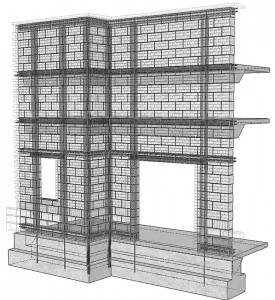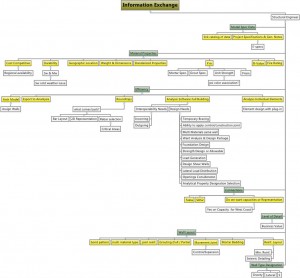What’s Coming for Structural Engineers
It’s been several years since the inception of Building Information Modeling (BIM) in our industry. Substantial progress has been made by the different software developers to provide us with the tools needed to tackle any type of project. As BIM use increases and progresses from design offices to construction trailers and fabrication shops, new needs emerge for the different professions and trades. When looking at structural building materials, the primary focus has been in the development of steel and reinforced concrete design and documentation tools. But what about masonry? Although it can be argued that many of the available features are interchangeable with concrete, masonry has very specific and unique needs that are not currently being met.
There is great software available for masonry modeling and design, but BIM efficiencies come from effectively sharing information across the different platforms and avoiding duplication of data input. The primary challenge we face is how to transfer spatial and design information between the different programs. The engineering community has been relying on software developers to prioritize the creation of solutions to satisfy our industry needs. Unfortunately, there has not been a unified approach to develop those tools consistently for all building materials, see sidebar.
The National Building Information Modeling for Masonry (BIM-M) Initiative was created to provide a roadmap to address that gap, and guide developers on masonry-specific needs.
BIM-M Initiative
The BIM-M Initiative was created to unify the masonry industry and all supporting industries through the development and implementation of BIM for masonry software. The initiative formed the following working groups to consider different perspectives in identifying challenges for masonry design and construction: Architectural Modeling, Structural Modeling, Construction Management, Construction Activities, and Material Suppliers Workgroups. These groups met last year to develop a vision for the development of BIM-M.
The BIM-M Initiative was developed and funded by the International Union of Bricklayers and Allied Craftworkers (IUBAC), the Mason Contractors Association of America (MCAA), the International Masonry Institute (IMI), the National Concrete Masonry Association (NCMA), the Western States Clay Products Association (WSCPA) and The Masonry Society (TMS). The primary consultant has been the Digital Building Laboratory at Georgia Institute of Technology and the masonry coordination is being provided by Biggs Consulting Engineering.
Structural Modeling Work Group (SMWG)
The SMWG focused on the interoperability between architectural, structural, and structural analysis models. The group identified a need for advanced tools that support structural masonry analysis and design. The SMWG considered the functionality and interoperability of current structural tools for masonry, and provided a roadmap for improved software capabilities. The workgroup’s mission was to identify process and BIM software needs required for efficient structural engineering design and economical construction of masonry systems (Figure 1). The effort is focused on improving the competitiveness of masonry by providing more reliable tools and information-sharing that result in improved delivery and quality of masonry projects.
As part of the roadmap, the workgroup created a list of must-haves in order to achieve the desired BIM tools for masonry. The list was prioritized in the following way:
Software Interoperability for Structural Engineering
Aside from everyone’s favorite spreadsheet, there are currently several standalone programs, like NCMA’s Structural Masonry Design System, that help design masonry-specific elements. Information has to be transferred manually from one program to the next, which increases the likelihood of human error and inefficiencies. There are also sophisticated analysis and modeling programs that perform linear and finite element analysis of masonry systems. Although overall geometry can be transferred across some of these programs, they can be greatly improved for geometry updates and transfer of additional design information, such as rebar. There is also a need for modeling masonry-specific elements such as pilasters, bond beams, lintels, etc. in a way that they can be intelligent and transferred between platforms that perform different functions. The workgroup defined a need for analysis software interoperability for both “full building” and “individual element” design.
There is a desire to have a reliable tool for “full building” design that shares information across platforms without having to duplicate data input. If reinforcing is assigned in the design software, it should be transferred to the documentation or fabrication software. A request was made to provide the necessary functionality to design building walls as systems, including foundations. Wall openings and overall layout coordination should be automated whether the system is resisting in-plane, out-of-plane, or gravity loads. Due to the iterative nature of masonry design, the software should be able to retain load distribution and load generation when changes to the design occur.
For the “individual element” design, the aspiration is to have at least one user-friendly plug-in that allows the engineer to design a specific masonry element within the documentation software. For example, design a lintel inside of Revit using an NCMA plug-in and have that design accurately represented graphically. See Figure 2 for an example of a load-bearing masonry construction with structural elements highlighted.

Figure 2: Virtual mock-up of load-bearing masonry construction with structural elements highlighted. Courtesy of Lena Klein and Russell Gentry, Georgia Tech Digital Building Laboratory.
Efficiencies in Design
Masonry design requires the input of many project specific material properties. In order to avoid duplication of work, we have to be careful about who has control over certain characteristics. Teams need to define ownership of information, not only ownership of model elements. If the architects model the walls that are also used for structural analysis, who specifies grout or mortar types? Is the color of block selected related to the unit’s strength? It’s important for each specialized party to have the ability to enter graphical and design data sequentially. That way, the model can evolve as data is layered onto different elements, instead of having to recreate them in different programs to serve one unique purpose. This will require software to allow properties of linked elements to be edited and structural components to be hosted to them. The programs will need to provide reliable change notification features and tolerate stable round trips without losing information.
Alongside those tools, there is a need for a comprehensive masonry material catalog because there currently is large variability of product specification and availability across the country. The BIM-M initiative gave the SMWG the opportunity to engage with the Material Supplier Work Group, which helped clarify a common desire for standardization of materials. When achieved, this will simplify masonry design and modeling.
When talking about BIM and transferring data across disciplines, the appropriate Level of Development (LOD) needs to be considered and established for each project. We’ve discussed ownership of information, but design teams also have to discuss what kind of information is being added to a model and why. Is there a need to know when a wall is fully or partially grouted? What’s the bond pattern? Where are the movement joints? Modeling this data can aid the design and field teams in many different ways. A strong tie between the project specifications and models will be required to manage that functionality.
Global Interoperability
The need for interoperability goes beyond architecture and structural. Other design teams, construction managers, general contractors, specialized sub-trades, and owners are interested in data output from BIM for different purposes.
The ability to identify and communicate key parts of a structural masonry system during design would simplify and improve the coordination process. Once this type of intelligence is built into the model, rules can be established to identify no-fly zones for other disciplines to recognize. For example, ductwork or piping wall penetrations could be coordinated electronically to miss running bond beams or grouted cells.
During construction, this added information would also benefit general contractors beyond clash detection. Construction Managers and General Contractors can use the increased functionality to plan construction sequencing, perform constructability reviews, overall scheduling, project management, and costing efforts. Ideally, these models will be passed onto fabricators and detailers, that can validate the data and extract 2D and 3D graphical representations to generate shop drawings effortlessly.
In recent years, we are seeing that more sophisticated contractors and owners are benefiting from extracting information from the BIM at different stages of a project. Complete models can provide detailed bill of materials and quantity take-offs that can be utilized for cost estimation and analysis.
Next Steps
The overall Roadmap for developing and deploying BIM for the masonry industry was released on January 31, 2013 (a link to the full document on the NCMA website is included in the online version of this article). This document captures the discussions and collaboration efforts from all five workgroups, and lays out the vision and groundwork for the next phases of the program. There are three phases of work being proposed: Development, Specification, and Implementation.
During Development, the team will develop a data structure for the digital representation of masonry units and masonry systems. It will be an effort to bring consistency in design with the involvement of masonry suppliers. During this phase, the BIM-M initiative will formalize a relationship with major software developers.
In the Specification phase, the focus will be on establishing a foundation for a software specification. With the involvement of software developers and contractors, there will be a focus on the development of structural engineering tools and construction workflows.
In the final phase, Implementation, the BIM for Masonry initiative will become a reality. Efforts will be directed towards the implementation of BIM-M from virtual architectural massing studies to real construction.
BIM and Other Materials
Structural steel has had well-established analysis software with 3D-capabilities that contains a large amount of design information for decades. With such a robust technological foundation, software developers have been able to create bi-directional links that satisfy the immediate needs of engineers seeking interoperability efficiencies.
Cast-in-place (CIP) concrete has similar well-developed finite element analysis tools that are very powerful and data-rich.
Although certain design information, such as reinforcement, is not currently being transferred, there is specialized software that allows rebar and connections to be modeled. Additional modules are being developed to simplify those tasks on different platforms.
Several BIM tools have also been created for wood and cold formed steel. There are plug-ins that recognize specific framing elements and use them to generate stick-frame layouts with analytical properties. This allows for the integration of design features and integrated generation of shop drawings.
Like masonry, precast concrete has unique needs. The Precast Concrete Consortium/ Precast/Prestressed Concrete Institute (PCI) and the Charles Pankow Foundation sponsored an effort to develop BIM requirements specific to precast that is now well underway.
Conclusion
As our industry adapts to the new changes brought on by the latest technological advances, it’s exciting to see professionals and organizations come together to lead such an ambitious initiative to ensure equal progress is made for all building materials. This all-inclusive effort not only strengthens the ties between all the parties involved, but it also shows the commitment of the masonry industry to continuous improvement and adaptability. Software development for unique systems, such as masonry, requires a deep understanding of the material, its uses, and construction methods. It’s design professionals that need to help drive that development and aid software companies to understand what we need. BIM-M is intended to be representative of the overall masonry industry, and will be successful if it captures the actual needs and wants of our engineering community. We ask that you take ownership of this development with us and reach out to any of the groups or individuals mentioned in this article if you have feedback, input, or comments.
Special thanks to the individuals that participated in the SMWG: Ross Shepherd, Ryan-Biggs Associates; Jeff Elder, Interstate Brick; David Biggs, Biggs Consulting Engineering; John Hochwalt, KPFF Structural Engineers; Amy Sellers, PES Structural Engineering; Jason Jones, PES Structural Engineering; Brian Johnson, Autodesk; Todd Dailey, Dailey Structural Engineers; Chad Boyea, PES Structural Engineering; Jamie Davis, Ryan Biggs Associates; and Craig McKee, Huckabee and Associates.▪
Others wishing to join this effort are requested to contact the author at tomas.amor@target.com.

